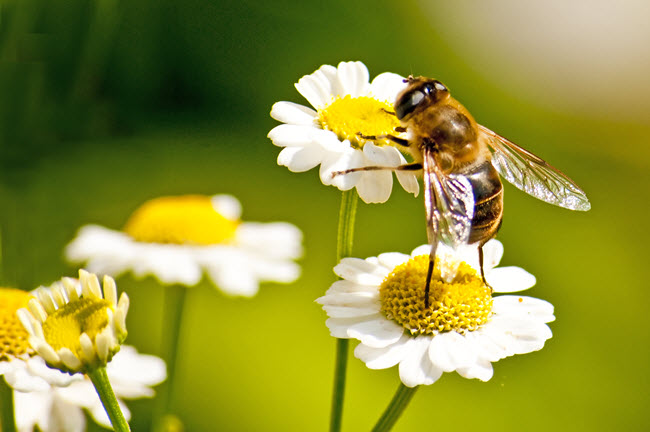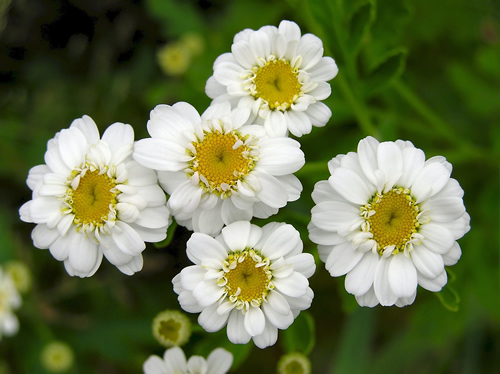Feverfew Herb
The botanical name for feverfew is tanacetum parthenium, belonging to the family Compositae. Parthenium is a derivative from the Greek “pur”, meaning “fire”, which is testament to the spicy hot taste of the root of the plant, and also to the blisters which form if the leaves are chewed.
This herb is a preeminent member of the Chrysanthemum flower group. The word feverfew is a derivative of the Latin term febrifugia, which means “fever reducer”.

Feverfew grows abundantly in gardens as well as other open spaces, and has become acclimatized all through a large portion of Europe.
Since feverfew has been introduced into the United States it has become a popular plant for herbalists and gardeners alike, being grown both as a traditional medicinal herb and also as an ornamental garden plant. Feverfew spreads quickly, covering an extensive area in just a few years if left unattended.
Plant Description
A short perennial, feverfew will grow into a small, aromatic bush up to approximately 20 inches tall. It gives off a strong, bitter, citrusy odor from the leaves when touched. The bright yellowish-green, chrysanthemum-like leaves grow alternately on both sides of the stem, turning downward and having short hairs. If chewed, the leaves have a spicy hot flavor.
The small, daisy-like, bright white flowers are arranged in a tight, level cluster. The white flowers have flat yellow centers, not unlike those of a daisy. This perennial blooms between late spring to the first frosts (June to October), depending on location.
Feverfew? Get Remedies Fast!
The cut flowers make a nice spring arrangement and will last for over a week if kept in water and out of the sun. The leaves can be mixed with dried wormwood to make a potent defense against moths.
Alternative Names
Feverfew is known in medical journals and encyclopedias by the botanical synonyms Pyrethrum parthenium and Chrysanthemum parthenium. Its common name is believed to have risen from the earlier name of featherfew, which referred to the feather-like leaves of the plant. Because of the plant’s efficacy in treating fevers, it became more commonly known as feverfew.
Other common names for feverfew include altamisa, bachelor’s button, bride’s button, chamomile grande, featherfoil, febrifuge plant, midsummer daisy, mutterkraut, nosebleed, wild chamomile, and wild quinine. The many common names of this plant attest to the many cultures and centuries of effective use.

History
The ancient papers of Greek physicians contain many references to feverfew. It has been used for hundreds of years by European folk healers to reduce or eliminate symptoms of headache, fevers, and reportedly arthritis. Early physicians also used the herb to treat menstrual disorders, stomachaches, toothaches, and even mundane insect bites. The many folk names of feverfew are proof that it has been known and used for centuries. It was also believed that the plant could act as an air purifier and ward off disease.
More recently, within the last 20 years or so, feverfew has been used by some herbalists and homeopathic doctors to treat migraine headaches. Secondary use is for arthritis and/or inflammatory symptoms or illnesses such as psoriasis.
Myths: True and False
A legend exists that feverfew saved the life of someone who fell from the Parthenon, a famous temple in ancient Greece. This is why parthenium is believed to be part of the botanical name.
A superstition reports that if feverfew is planted around homes it will purify the air and ward off disease. Since the pungent odor is offensive to bees, people used to carry branches to ward the bees off.
According to one very old text, feverfew should be “pulled from the ground with the left hand, and the fevered patient’s name must be spoken forth, and the herbalist must not look behind him.”
People Who Have Used It
Dioscorides, a Greek herbalist, treated arthritis with feverfew. Nicholas Culpepper, a famous English pharmacist, prescribed the plant for “all pains in the head”. Another celebrated herbalist, John Hill, used it to “cure the worst headaches”.
Habitat: Where and How It Grows
Feverfew is native to Eurasia, more specifically the Balkan Peninsula and the Caucasus, but has been transplanted to all of Europe, North America, the Mediterranean, Chile, and Australia. This perennial likes full sun, though it will grow in partial shade, and should be planted 15 to 18 inches apart. It can grow as high as 2 feet in ideal conditions. Feverfew is hardy to USDA zone 5 (-22 degrees Fahrenheit).
This perennial likes well-drained, manure-enriched soil, but will grow even in poor soil. The best time to plant is toward the end of April, after danger of frost has passed, but it can also be planted in the autumn. It may be propagated by seed (started in February, planted in April), by division (best accomplished in March, roots should be divided in 3 or 5 pieces), or by cuttings (cut the shoots, then put in a bed of slightly sandy soil; plant through the winter, October to May).
Seeding
While the plants are young, watch for snails and slugs. Spray the plant with a cayenne pepper wash if slugs are a problem.
Feverfew seeds itself easily, and will grow outside the garden borders if left to itself. If planted in partial shade, the leaves will be darker than in full sun. If planted in a sheltered location, it will survive a mild winter uncovered and untended. After the first blooming, cut it back and a second blooming will occur late in the summer. In the fall it should be cut down to the ground.
It grows easily and quickly, making it ideal for filling in border and pathway gaps or to edge the driveway. It is a very pretty ornamental, and mixes well with other flower garden plants.
Parts to Use
The stems, leaves, and flowers can be used. Do not use the roots of this plant. The leaves can be eaten fresh to relieve headaches, but blisters in the mouth are a common side effect of utilizing feverfew in this way. Stems, leaves, and petals can be chopped and infused into a tea by steeping in water.
Chopped and mixed with alcohol, a tincture can be made, stored, and added by dropper as needed. A poultice can be made by sautéing the chopped herb in a little oil, then placing the sautéed contents into a clean towel, muslin, or cheesecloth for placement on the body.
Typical Uses
Headaches
The most common current day use for feverfew is to reduce or eliminate headaches. Herbalists familiar with this plant have been known to remove a leaf from the plant and immediately chew it to get rid of a headache, though this isn’t recommended since it can cause blisters in the mouth.
Migraine headaches
A more violent form of headache, migraines have been successfully treated using feverfew. This is particularly helpful for people who do not react well to the prescription medications typically prescribed for migraines. Some ardent proponents tout the benefits of feverfew to prevent migraines, but the efficacy of this treatment has not been scientifically proven and so at this time is merely anecdotal.
Arthritis
Centuries-old annotations about the efficacy of feverfew on arthritis have been found in physicians’ texts. Feverfew’s anti-inflammatory properties have been used with good effect on arthritis, including rheumatoid arthritis.
Fever reducer
This was a common use for feverfew until the last century or so, when the use of aspirin became widespread. Passionate traditional herbalists still prefer feverfew over aspirin. Homeopaths use this as a hot infusion to help sweat out the fever.
Menstrual cramps
This is a well-documented use for feverfew, as it soothes cramps and promotes regular menstrual flow. For this reason, it should not be used by any woman who suspects she may be pregnant.
Laxative
This can be used for either a mild or a strong laxative, depending on how you use it.
Gas – The herb can be used to relieve gas and bloating, but too much will have the opposite effect.
Vermifuge
Feverfew can be used to expel parasitic worms from the intestines.
A study in 2005 found that feverfew induces cell death in the stem cells of leukemia. Further studies on the efficacy of feverfew on cancer in general have not been released. Feverfew contains a goodly amount of melatonin, used for natural sleep. It also has GABAergic effect, and so is a mild depressant.
Most Common Forms
Feverfew can be home grown or purchased commercially. Popular supplement forms are available in fresh, freeze-dried, or dried regularly. It is available in capsule, tablet, fresh dried leaves (for tea) or in liquid extract forms.

Most of the supplements have a standardized dose of parthenolide, which is believed to be the active compound in feverfew. A standard dose of parthenolide is between 0.2% and 0.4%. In extract form, a standardized parthenolide dose is 250 micrograms (mcg).
Be sure to read the label to verify percentage or micrograms of parthenolide. Although the stems, leaves, and flowers can be used medicinally, commercial versions of feverfew typically use only freeze-dried leaves.
Prepared extract should be stored carefully in the refrigerator. Normal temperatures have been shown to render some ingredients ineffective.
Typical dosage and usage regimen
Pediatric
Do not use feverfew on children under the age of 2. For older children, the adult dose should be adjusted based on the weight of the child. Adult doses are formulated for a person with an average weight of 150 lbs. Accordingly, if the child weighs 50 lbs. the correct dose would be one third of the recommended adult dose.
Adult
Migraine headaches
Use 100-300 mg. with a standardized 0.2-0.4% parthenolide, up to 4 times each day.
Migraine headache preventative
Using freeze-dried capsules, take 200-250 mg. per day. Some literature suggests that it can take several weeks to notice a significant improvement.
Inflammatory conditions
From 5-30 drops of tincture 4 times daily for arthritis or psoriasis.
As with any herb, start with a small dose to see how it affects you. For instance, if the recommended dose is between 100-300 mg. per day, begin with the 100 mg. and monitor for effect. Increase the dose as needed, but don’t just start with the largest dose.
Many people think “if one will do the job, three will do it better or faster”, but that’s not the case. Too much of any herb can cause unpleasant side effects. See below.
Popular brands available on the market
Feverfew is widely available both online and in many supermarkets. Some common brands include GNC and Nature’s Way.
Feverfew is also used by Aveeno, Neutrogena, Dermalogica, and Clean and Clear skincare brands to calm red and irritated skin and in a variety of beauty treatments.
Why It Works
The active ingredient in feverfew is considered to be parthenolide. For migraines, it is believed that feverfew inhibits the release of serotonin and prostaglandins, which are thought to aid migraine onset. This reduces inflammation of the blood vessels in the head, which in turn is believed to stop the blood vessel spasms which contribute to the headache.
Feverfew appears to inhibit the release of polymorphonuclear leukocytes in arthritic joints, which reduces inflammation. The herb’s ability to inhibit production of prostaglandins makes it useful to treat conditions such as psoriasis. It is also considered an anticoagulant, and so will keep blood clots from forming.
A study in 2005 found that feverfew induces cell death in the stem cells of leukemia. Further studies on the efficacy of feverfew on cancer in general have not been released. Feverfew contains a goodly amount of melatonin, used for natural sleep. Some other chemical and nutritional components include B-vitamins, beta-carotene, calcium, flavonoid glycosides, iron, magnesium, manganese, phosphorus, potassium, selenium, vitamin C, and zinc.
What It Has Been Proven To Do
Many studies and anecdotal evidence have proven that feverfew is effective in treating headaches, dysmenorrhea, poor menstrual flow, inflammation, asthma, and digestive problems. It is also used to good effect for insect and vermin bites, reducing the pain and swelling.
A non-medicinal use includes insect repellent (dilute with water and use as a spray).
Unproven Claims
Although anecdotal evidence and case reports abound, a scientific study of human subjects reported that feverfew was as ineffective as a placebo in treating rheumatoid arthritis. Therefore, the efficacy of feverfew in treating osteoarthritis or rheumatoid arthritis has not been scientifically proven yet.
Legal Status
Feverfew is legal everywhere in the United States and around the world.
Potential Side Effects
Using herbs is a time-honored practice which predates modern medicine. Like medicines, however, herbs can cause side effects and can interact or interfere with prescription medications, other herbs, or supplements. All herbs, including feverfew, should be taken with caution and with the supervision or advice of a qualified herbalist.
The most often reported side effects include gastrointestinal distress, ulcers of the mouth, and antiplatelet actions. Other side effects include abdominal pain, indigestion, gas, diarrhea, nausea, and vomiting. Also, people who have chewed the leaves have reported blisters of the mouth and temporary loss of taste. Swelling of the lips, tongue, or mouth have been reported.
Prior to Surgery
Because of the anticoagulant properties of feverfew, it should not be taken prior to surgery. Also, persons taking blood thinners or anticoagulants or have blood clotting difficulty, should completely avoid feverfew.
Pregnant Women & Children
It should not be used by pregnant women or women who are thought to be pregnant. Feverfew should also not be used by breastfeeding women, as it can transmit through breast milk to the infant.
Infants and children under the age of 2 should never be given feverfew.
Continuos Use & Allergy Information
If feverfew has been taken continually for a period of time, sudden discontinuation can cause withdrawal. Symptoms of withdrawal include headache, irritability, restlessness and difficulty sleeping, and joint pain.
Persons who have demonstrated an allergy to ragweed, chamomile, or yarrow are likely to have an allergy to feverfew as well and should avoid taking it.
Possible Interactions
Feverfew can alter or negate the effects of some prescription and/or over the counter medications. You should not use feverfew if you are taking any of the following medications: blood thinners such as aspirin, warfarin or coumadin, or NSAID medications. Some reports have indicated that feverfew can make NSAID medications ineffective. The reverse is also true.
Cost
Feverfew is relatively inexpensive. A bottle of 300mg. capsules, with 100 capsules in the bottle, can be found for as little as $4.00 or as much as $21.00, depending on where you purchase it.
Where You Can Find It
Feverfew may be purchased online at locations such as drugstore.com or puritan.com, at vitamin stores such as GNC, or in supermarkets such as Publix or Walmart.

2 Comments
The last thing I need is to gain weight as I worked very hard to lose 40 pounds to get back to my healthy weight. 49 y/o female, 5’7″, 140 lbs… I have chronic migraines and my husband purchased the GNC 380 mg. capsules of Feverfew… Will I gain weight? What do studies show? I’m getting conflicting information.
Respectfully,
Dena
Hello! Appreciate your informative site! Just want to mention that Migraine is not simply a ‘more violent form of headache’. It is a genetic neurological disease of which the head pain (typically, not always) is but one symptom. It’s important that we dispel commonly held assumptions about this disease.